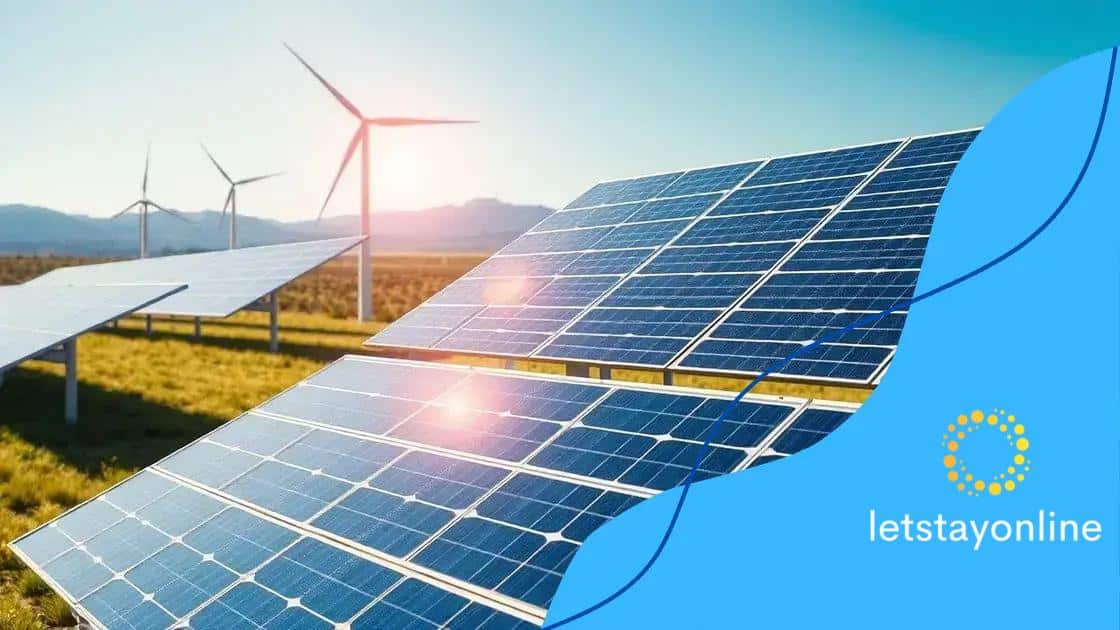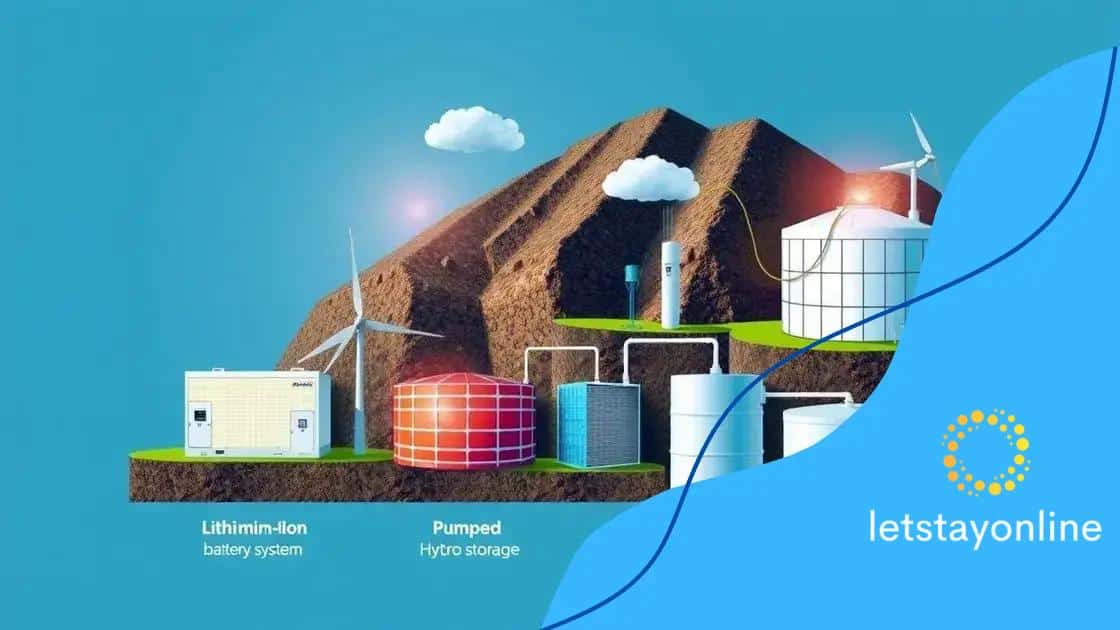Advances in renewable energy technology in 2025

Advances in renewable energy technology in 2025 include innovations in solar, wind, and geothermal systems, driven by supportive policies and incentives that boost efficiency and sustainability.
Advances in renewable energy technology in 2025 are set to revolutionize how we harness power. Curious about what innovations are on the horizon? Let’s dive into the exciting developments shaping our energy future.
Key innovations in solar energy
Solar energy is rapidly evolving, and the key innovations in solar energy are making this renewable resource more efficient and accessible than ever before. In recent years, we’ve seen groundbreaking advancements that can transform how we utilize the sun’s energy.
Advanced Solar Technologies
One of the most exciting developments is the improvement in solar panel efficiency. New materials, such as perovskite solar cells, are being developed that can significantly outperform traditional silicon panels. These advancements allow for higher energy conversion rates, making solar energy a more viable option for many households and businesses.
Innovative Energy Storage Solutions
Another area of innovation includes energy storage technologies. With the growing demand for solar energy, effective storage systems are crucial. Companies are now producing batteries that can store solar energy much more efficiently, allowing users to harness power even when the sun isn’t shining.
- Higher energy capacity
- Longer lifespans
- Quicker charging times
- More environmentally friendly materials
Furthermore, integrating solar energy systems with smart home technology is becoming increasingly popular. This integration means that households can monitor and control their energy consumption more effectively, leading to reduced costs and increased sustainability.
Solar Panel Design Innovations
Design improvements are also making solar panels more attractive. Companies are creating aesthetically pleasing panels that can blend into buildings without sacrificing performance. This shift can help promote the adoption of solar energy by making it a more desirable option for homeowners.
As we look at the future of solar energy, the emphasis on sustainability and efficiency will continue to drive innovations. These advancements not only improve energy production but also contribute to a cleaner environment.
Wind power advancements
Wind power is a crucial part of the renewable energy landscape, and there have been significant advancements in wind power technology recently. These innovations are improving efficiency and making wind energy a more competitive option.
Enhanced Turbine Designs
One major advancement is in turbine design. New, larger turbines can capture more energy from the wind. These turbines have longer blades and are built higher, allowing them to access stronger winds. As a result, they can produce more electricity than their smaller counterparts.
Smart Technology Integration
Another exciting development is the integration of smart technology into wind farms. Using sensors and data analytics, operators can monitor turbine performance in real-time. This ability leads to better maintenance planning and ensures turbines operate at peak efficiency.
- Predictive maintenance capabilities
- Enhanced energy output monitoring
- Automation of operations
- Improved safety measures
Furthermore, the offshore wind sector is also experiencing rapid growth. Offshore wind farms can harness higher and more consistent wind speeds compared to onshore sites. The larger space available at sea allows for the installation of even more efficient turbines.
Lastly, advancements in energy storage technologies are making it easier to store and use wind energy efficiently. These systems help balance supply and demand, making wind power a reliable energy source, even when the wind isn’t blowing.
Energy storage solutions

Energy storage is a vital component of the renewable energy system, and the growing demand for energy storage solutions is helping to balance supply and demand. These solutions enable us to make the most of renewable sources like solar and wind.
Types of Energy Storage Technologies
There are different types of energy storage technologies available today. Each type plays a unique role in energy management.
- Batteries: Battery storage systems capture energy for later use. Lithium-ion batteries are the most common for home and commercial use, offering efficient storage and quick response times.
- Pumped hydro storage: This method uses water reservoirs. Water is pumped to a higher elevation when energy is plentiful, and when it’s needed, it flows down to generate electricity.
- Flywheels: Flywheel systems store energy in the form of kinetic energy. They can quickly release energy, making them ideal for stabilizing the grid.
- Thermal storage: This involves storing heat or cold energy. It allows facilities to use stored thermal energy when needed, providing efficiency.
The choice of storage technology depends on specific needs such as capacity, duration, and response time. For many areas, integrating several storage options can create a more reliable energy system.
Benefits of Energy Storage Solutions
Energy storage solutions provide several important benefits. They enhance the reliability of power supply and increase the resilience of the grid. During peak demand times, these systems can discharge stored energy, helping to reduce the overall energy cost. Additionally, they support renewable energy integration by mitigating the variable nature of wind and solar power.
As technology progresses, we can expect to see further enhancements in energy storage systems, making them more affordable and efficient. This positive trend will play a critical role in achieving a sustainable energy future.
Emerging technologies in geothermal energy
Emerging technologies in geothermal energy are paving the way for a cleaner and more sustainable energy future. These innovative systems harness the earth’s natural heat, providing a reliable energy source.
Enhanced Geothermal Systems (EGS)
One of the most promising developments in geothermal energy is the increasing use of Enhanced Geothermal Systems (EGS). EGS technology allows for the extraction of geothermal energy from dry rock formations, which expands the potential for geothermal power production. This method creates artificial reservoirs where water is injected, heated, and then extracted to produce energy.
Binary Cycle Power Plants
Another significant advancement is the use of binary cycle power plants. These plants utilize two fluids to convert geothermal heat into electricity. The geothermal fluid heats a secondary fluid with a lower boiling point, which vaporizes and drives a turbine. This technology allows for lower temperature resources to generate electricity, making geothermal energy more versatile.
- Higher efficiency rates
- Lower environmental impact
- Ability to utilize lower temperature resources
- Reduced water usage
Innovative drilling technologies are also transforming geothermal energy extraction. Techniques such as directional drilling and advanced drilling fluids enable access to deeper and hotter geothermal resources, which were previously unattainable. This advancement can lead to more efficient energy production and lower operational costs.
Direct Use Applications
In addition to electricity generation, emerging technologies are enhancing direct use applications of geothermal energy. This includes heating buildings, greenhouse agriculture, and aquaculture, among other uses. These applications are not only efficient but also reduce reliance on fossil fuels.
As these technologies evolve, the potential for geothermal energy to contribute significantly to reducing greenhouse gas emissions increases. The ongoing research and development in geothermal systems promise to unlock further benefits for energy generation and consumption.
The role of policy in renewable energy progress
The role of policy in renewable energy progress is crucial for driving the adoption of sustainable energy sources. Government policies can significantly influence how quickly renewable technologies develop and expand.
Incentives and Subsidies
One key factor is the implementation of incentives and subsidies. Governments often provide financial assistance to both individuals and businesses that invest in renewable energy projects. This support can make a significant difference in the affordability of solar panels, wind turbines, and energy-efficient appliances.
- Tax credits for solar and wind energy investments
- Grants for research and development of new technologies
- Subsidized loans for renewable energy installations
- Feed-in tariffs to guarantee prices for renewable energy producers
Additionally, policies that promote renewable energy can create a more favorable regulatory environment. Streamlining the permitting process and reducing bureaucratic hurdles can make it easier for companies to develop renewable energy projects.
Renewable Energy Standards
Another aspect of policy is the establishment of renewable energy standards. Many countries set targets for renewable energy production within their overall energy mix. These mandates push utilities and energy producers to prioritize the development of clean energy sources over fossil fuels.
International agreements, like the Paris Agreement, also drive policy changes on a global scale. Countries committed to reducing their carbon emissions must invest in renewable energy to meet their targets. This global pressure encourages nations to adopt more ambitious energy policies.
Moreover, local and regional policies can also play a significant role. Community solar projects and local energy initiatives empower citizens to engage in renewable energy adoption at the grassroots level. These activities not only enhance energy independence but also promote broader public support for sustainability efforts.
FAQ – Frequently Asked Questions about Renewable Energy Technology
What are the main types of renewable energy technologies?
The main types include solar, wind, geothermal, hydroelectric, and biomass energy technologies.
How do government policies impact renewable energy?
Government policies provide incentives, set standards, and create an environment that encourages investment in renewable energy sources.
What are the benefits of using renewable energy?
Renewable energy reduces greenhouse gas emissions, decreases reliance on fossil fuels, and promotes energy independence.
Can renewable energy technology meet global energy needs?
Yes, with continued advancements and investments, renewable energy can significantly meet global energy demands in a sustainable way.






